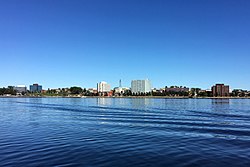
Back Sydney, Nova Scotia Afrikaans سيدنى (كاپ بريتون كونتى) ARZ Сидни (Нова Скотия) Bulgarian Sydney (lungsod) CEB Sydney (Nové Skotsko) Czech Sydney (Nova Scotia) German Sydney, İskoçya Newiye DIQ Σύντνι Greek Sydney (Nueva Escocia) Spanish Sydney (Nova Scotia) Estonian
Sydney | |
|---|---|
 Sydney waterfront as viewed from Westmount | |
| Nickname: The Steel City | |
| Coordinates: 46°08′11″N 60°11′44″W / 46.13639°N 60.19556°W | |
| Country | Canada |
| Province | Nova Scotia |
| County | Cape Breton |
| Municipality | Cape Breton Regional Municipality |
| Founded | 1785 |
| Incorporated City | 1904 |
| Amalgamated | 1 August 1995 |
| Named for | Thomas Townshend, 1st Viscount Sydney |
| Area | |
• Total | 30.91 km2 (11.93 sq mi) |
| Highest elevation | 66 m (217 ft) |
| Lowest elevation | 0 m (0 ft) |
| Population (2021)[citation needed] | |
• Total | 30,960 |
| • Density | 1,000/km2 (2,600/sq mi) |
| • Metro density | 718.50/km2 (1,860.9/sq mi) |
| "Metro" population based on a 43 km2 or 17 sq mi sample that is larger than the old boundaries for the former City of Sydney, pre-1995. | |
| Time zone | UTC– 04:00 (AST) |
| • Summer (DST) | UTC– 03:00 (ADT) |
| Canadian Postal code | B1L – S |
| Area code | 902 & 782 |
| Telephone Exchange | 202, 217, 270, 284, 304, 317, 322, 371, 408, 509, 537, 539, 549 560–5, 567, 574, 577, 578, 595, 979 |
| Highways | |
| Website | sydney |
Sydney is a former city and urban community on the east coast of Cape Breton Island in Nova Scotia, Canada within the Cape Breton Regional Municipality. Sydney was founded in 1785 by the British, was incorporated as a city in 1904, and dissolved on 1 August 1995, when it was amalgamated into the regional municipality.
Sydney served as the Cape Breton Island's colonial capital, until 1820, when the colony merged with Nova Scotia and the capital moved to Halifax.
A rapid population expansion occurred just after the turn of the 20th century, when Sydney became home to one of North America's main steel mills. During both the First and Second World Wars, it was a major staging area for England-bound convoys. The post-war period witnessed a major decline in the number of people employed at the Dominion Steel and Coal Corporation steel mill, and the Nova Scotia and Canadian governments had to nationalize it in 1967 to save the region's biggest employer, forming the new crown corporation called the Sydney Steel Corporation.[1] The city's population has steadily decreased since the early 1970s due to the plant's fortunes, and SYSCO was finally closed in 2001. Today, the main industries are in customer support call centres and tourism. Together with Sydney Mines, North Sydney, New Waterford, and Glace Bay, Sydney forms the region traditionally referred to as Industrial Cape Breton.
- ^ Lebel (1967), pp. 1, 2.
